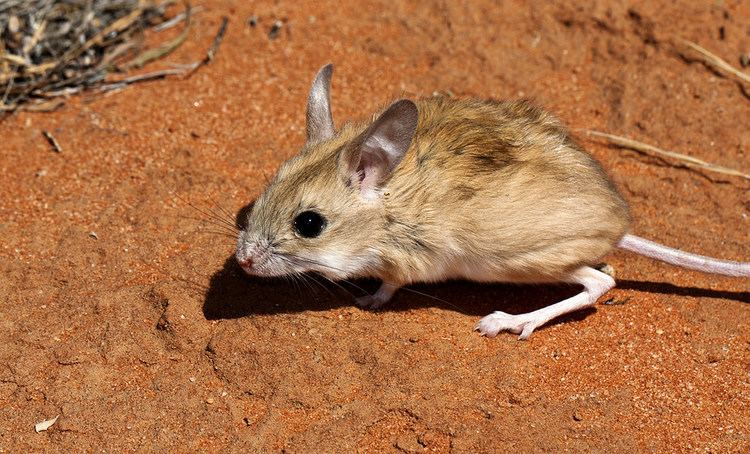Kingdom Animalia Subclass Eutheria Family Muridae Scientific name Notomys fuscus Rank Species | Phylum Chordata Order Rodentia Genus Notomys Higher classification Hopping mouse | |
 | ||
Similar Hopping mouse, Fawn hopping mouse, Mammal, Northern hopping mouse, Rodent | ||
The dusky hopping mouse (Notomys fuscus) is an Australian native rodent specialised for the deep desert. Like all hopping mice it has strong front teeth, a long tail, dark eyes, big ears, well-developed haunches and very long, narrow hind feet. It weighs between 20 and 50 g (0.71 and 1.76 oz). (Compare with the common house mouse, at 10 to 25 g (0.35 to 0.88 oz).)
The dusky hopping mouse has four pads on its soles. Colouration varies but tends to be pale orange, sometimes with grey tinges, and white underneath. Fur is short, fine, and soft. The long tail ends in a dark brush.
Breeding is opportunistic, depending on conditions rather than the time of year. Females have four teats and the young reach maturity in about 70 days.
The dusky hopping mouse is classified as vulnerable. Old records show that it once occupied a large area of Central Australia including parts of Queensland, New South Wales as far as Victoria, the Northern Territory and South Australia but it now appears to be restricted to a small number of locations in the Strzelecki Desert and nearby regions in the South Australia–Queensland border area. It is possible that some survive in the Northern Territory also, though surveys in 2000 and 2002 did not find any.
The remaining populations are concentrated in sandy habitats which have consolidated dunes and perennial vegetation and are close to lakes or drainage lines. (Bear it in mind that "lakes" in Central Australia are normally dry, often for years on end: permanent surface water is very unusual.) Dusky hopping mice are nocturnal and gregarious. During the days, they shelter in very deep burrow systems. The access shafts are about 3 cm (1.2 in) in diameter and go straight down for about 1.5 m (4 ft 11 in).
The reasons for the decline of the dusky hopping mouse are not fully understood, but are assumed to be competition for food with introduced species, particularly cattle and rabbits, and predation by introduced cats and foxes. Decline due to predation by introduced predators appears to be a factor, since it has been found that this species is up to 40 times as abundant in areas where dingos are present, due to the dingo's competitive exclusion of foxes.
